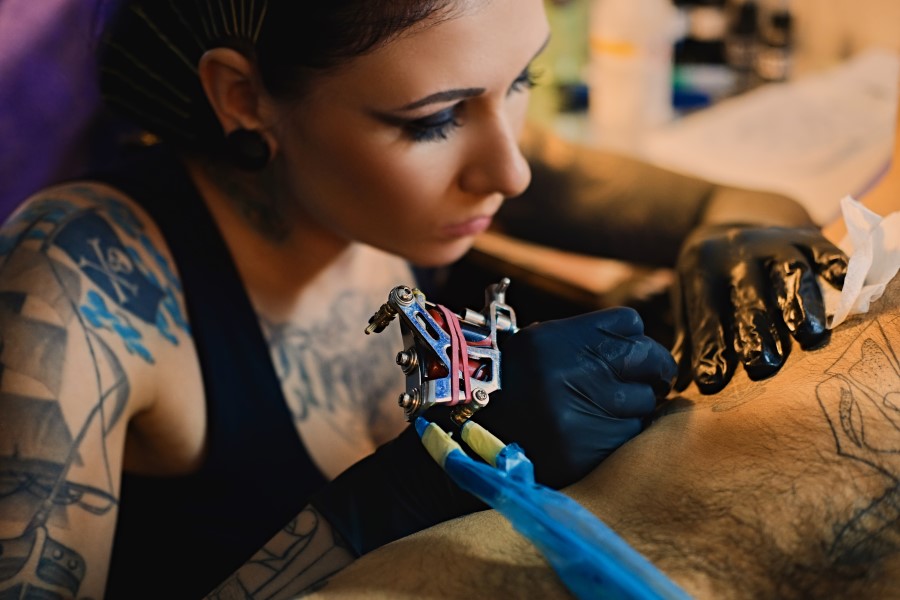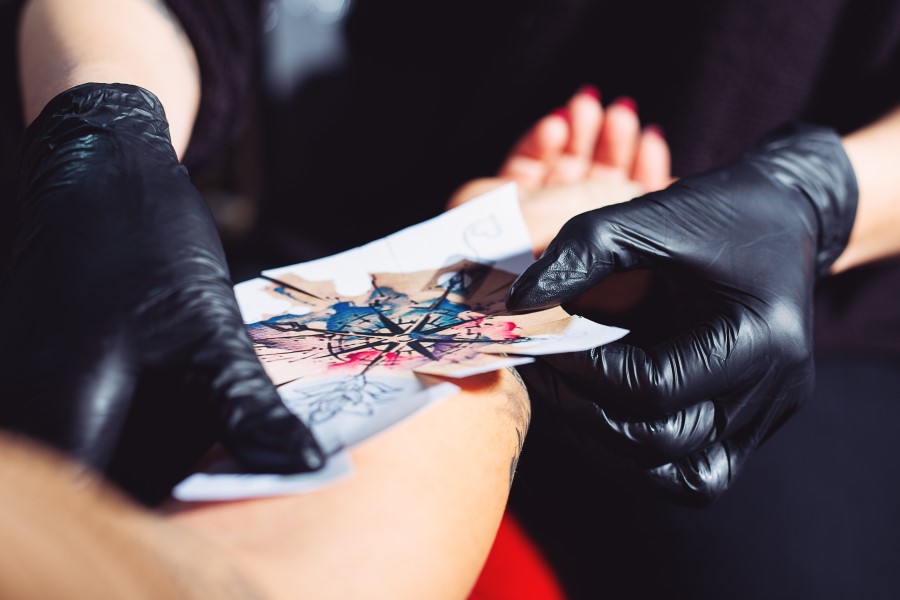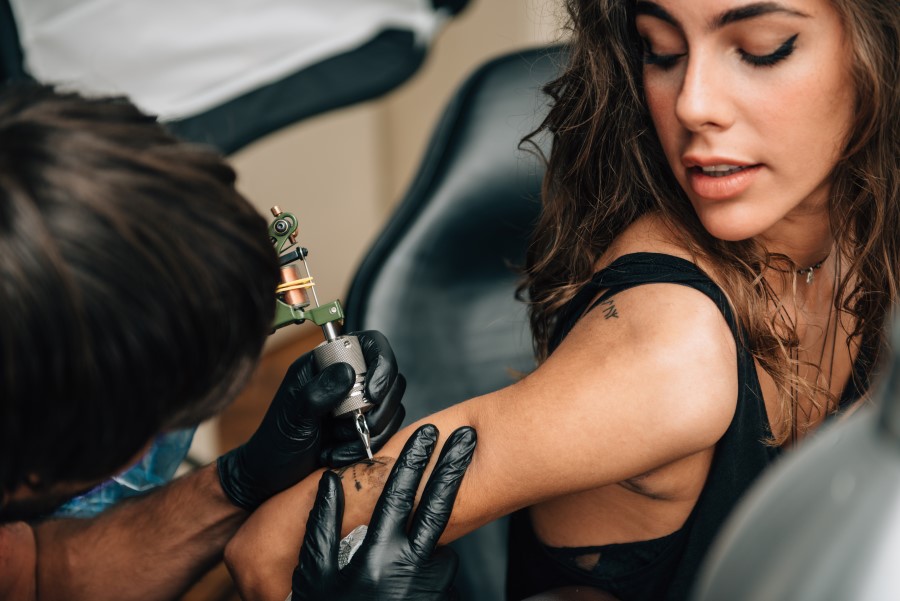Your skin ages, and tattoos age with it. But tattoo aging also has natural causes, as the body gradually breaks down inks. By looking after your skin properly, you can counteract tattoo aging.
Tattoo aging obeys various causes. Below is an explanation for tattoo aging and what you can do about it. Notice that it is better to follow some anti-aging tips for your tattoo before you get it!
Table of contents
- A brief and concise explanation of tattoo aging
- Tattoo aging varies depending on the body area where tattoos are located
- Tattoos for different body areas!
- Light favours tattoo aging
- Care helps against tattoo aging right from the start
- Blurred contours? You can do that!
- Last option – having your tattoos re-stitched

A brief and concise explanation of tattoo aging
Tattoos change their appearance over the years. This process is called tattoo aging. Tattoos may fade, to which case we refer as fading, a term which comes from the English word “to fade” meaning “to fade” or “to disappear”. Blurring or blow-out takes place when the sharpness of your tattoo contours diminishes.
The causes of these changes are complex. On the one hand, they are due to the natural aging skin process, which also makes a tattoo age. Additionally, UV rays and friction are the strongest reasons for tattoo aging. You do not just have to accept tattoo aging. With a good care routine and a few simple rules of conduct, you can slow down the process considerably.
Your tattoo in 3 steps
In your first consultation you will receive personalized information on your tattoo. Contact us on our email address or superchat (bottom right symbol).
Make an appointment.
Your tattoo dream will be carried out in a relaxed atmosphere.

Tattoo aging varies depending on the body area where tattoos are located
Tattoos age at different rates and to different degrees, depending on the body area where they are located. Premature tattoo ageing mainly affects tattoos that are located on skin areas frequently rubbed by clothing. Similarly, colours fade faster where the skin is stretched more frequently. These body areas are particularly affected:
- Hands
- Fingers
- Arms and especially elbows
- Wrists
You wash your fingers and hands frequently, dry them and touch objects. All this means friction. Your wrists are in the cuffs of your sleeves, which also rub. Firstly, your elbows are often supported, and secondly, the skin here is moved a lot every time you bend and stretch. The same applies to the other joints.
You probably know yourself quite well as for where clothing rubs against your body, which parts of your body are more frequently exposed to the sun and how you move. In order to have your tattoo done, choose the area of your body where stress is not too great. Talk to your tattoo artist if you want to find out more! They can help you find the right spot for your desired design.

Tattoos for different body areas
As you get older, your skin loses elasticity gradually. It hangs a little, appears to be “too big” for your body and becomes more wrinkled. This process changes your tattoo contours.
These changes are particularly pronounced in body areas affected by weight fluctuations. If you build up noticeable muscles or lose your muscle mass, the skin and therefore your tattoo will also change. In women, pregnancy and breastfeeding cause changes to the skin and tattoos. Tattoo aging caused by skin aging is particularly noticeable on the following body areas:
- Stomach
- Chest
- Upper arms
- Waist
- Bottom
Other body areas are significantly less affected by aging signs. This includes the area around your collarbone and also your forearm and back. The neck area is singularly beautiful, since it does not lose its elasticity with age.

Light favours tattoo aging
Why does the skin age and lose its elasticity? The mechanisms behind this are not yet fully understood. However, UV radiation is an important factor because it causes skin cells to age prematurely and robs them of their ability to regenerate, a fact to which tattoo aging is closely linked. You may be familiar with this: if garden furniture is left outside the whole summer, its colours look different afterwards. They are paler and lack luminosity due to UV radiation, causing colours to fade, as well as diminishing brilliance and luminosity.
Tattoo inks are pigments which react sensitively to light, especially to UV rays. Red tattoo inks fade particularly quickly. Their pigments are photochemically split by UV radiation. As a result, pigmentation is less concentrated and your tattoo colour loses brilliance.
Under the influence of UV radiation, your skin produces more collagenases. These enzymes break down the skin collagen fiber network, therefore weakening the skin and making it less elastic. In addition, the skin becomes drier due to high light exposure. Dry, rough skin makes tattoos look even paler.
Our tip: use a high sun protection factor (50+) when you go out in the sun or enjoy the solarium. Sun protection not only protects your skin, but also your tattoo.
Care helps against tattoo aging right from the start
Even during the healing phase, your tattoo needs care, so trust your body’s self-healing powers and protect your tattoo with a breathable plaster on the first days after getting it. It is normal for some tattoo ink to be washed out with wound secretion. This is why your tattoo will appear paler than immediately after being pierced.
From the fourth day after the sting on, special creams support further healing. Above all, it is important that the skin and scab remain moist and do not tear. This allows your tattoo to heal without scarring. Colour pigments remain intense and glowing for a long time. Once your tattoo has healed completely, treat it with a special care product for tattooed skin. This is the most effective care against tattoo aging!
Blurred contours? You can do that!
If your tattoo is still new and has just been engraved, it is normal for its contours to look a little blurred. Do not worry – it only looks like that! There are tiny bruises, swelling and redness in the skin around your tattoo, which makes it look blurred. As soon as your tattoo heals, its contours will become clear. Additionally, if you pamper your skin with moisturizer, they will stay that way for a lifetime.
Notice that very fine tattoos, minimalist tattoos, such as dots and fineline works, as well as floral patterns and delicate lettering, are more affected by tattoo blurring than other tattoos. This is completely normal and has nothing to do with your tattoo quality.
Last option – having your tattoos re-stitched.
It is completely normal for tattoos to lose their colours over time. The skin heals, a part of its pigment is flushed out with wound fluids and the skin ages. If you no longer like your tattoo at all or it is barely recognizable, you can have it re-stitched. However, this should not be done for at least six weeks after getting your tattoo. You should definitely wait that long, because only then will the healing process be completed. If your tattoo is still too pale, a little more colour can help.
Despite re-engraving, high-quality work and a lot of effort on the part of your tattoo artist, your tattoo will eventually become paler. Take care of it daily with special creams and lotions for tattooed skin. This way you can prevent premature tattoo aging and keep colours brilliant for a longer period of time.

